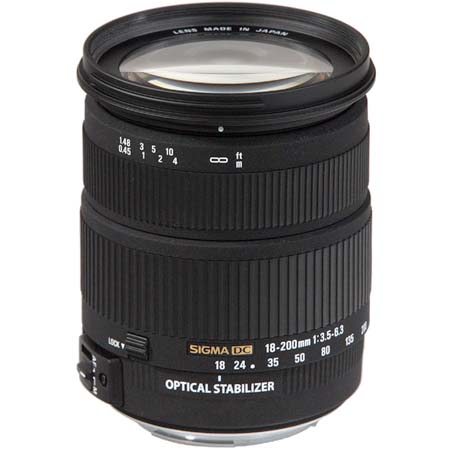
If you own or have used this lens, let us know what you think! Leave your comments and thoughts below. Get information and user reviews for this lens from Amazon: Sigma AF 18-200mm f/3.5-6.3 DC OS (Optical Stabilizer) Zoom Lens for Canon Digital SLR Cameras
Photo Zone
The Sigma AF 18-200mm f/3.5-6.3 DC OS is an extremely versatile lens but performance-wise it is a bit of a mixed bag. The resolution characteristic varies significantly throughout its immense zoom range. Interestingly the extreme ends are actually the sweet spots of the lens whereas the 35mm setting is downright miserable at large apertures. The quality recovers at 50mm before dropping somewhat at 100mm again. To be fair the lens is capable to provide a decent quality if you avoid large aperture settings and stick to ~f/9 regardless of the zoom position. On the positive side vignetting and CAs are quite well controlled and distortions may be a problem at 18mm only. The quality of the bokeh (out-of-focus blur) is sometimes less than stellar though. The AF speed and accuracy is pretty fine and the image stabilizer can give you an advantage equivalent to about 3 f-stops in field conditions. The build quality of the Sigma is surprisingly good and above average for a lens in this class. READ FULL REVIEW
Other Sigma 18-200mm f/3.5-6.3 DC OS AF Reviews
Digital Picture
The Sigma 18-125mm f/3.8-5.6 DC OS HSM Lens review is a reasonably-priced lens that comes in a small package and packs a really nice focal length range. Barrel distortion is apparent at 18mm (this is no surprise), but pincushion distortion quickly sets in over the rest of the focal length range. Pincushion distortion is especially strong between 35 and 60mm and again in the low 70s. The pincushion distortion makes the ISO 12233 resolution chart results appear even worse due to the reduced detail size. This is not a real sharp lens even stopped down. CA (Chromatic Aberration), while not harsh, is apparent in the middle and worse at the corners of the frame at both ends of the focal length range. On the wide end, CA mostly clears up by 35mm and is once again apparent at and above 100mm. Color appears neutral. ? ?Flare ranges from well controlled on the wide end to quite noticeable on the long end if there is a bright light in the corner of the frame. Some vignetting is visible in the corners at 18mm but there is not much to worry about in this regard at longer focal lengths. My experience with this lens’ autofocus accuracy has not been the best. I am getting the best results from the widest angles with hit rates deteriorating as the focal length increases. Even the relatively wide DOF (Depth of Field) delivered at this lens’ max aperture are not enough to hide the inconsistencies. READ FULL REVIEW
SLR Gear
It’s hard to overlook the obvious problems with sharpness but what I find most fascinating is how isolated they are. If you were fine living without 28, 35 and 80mm, somehow magically avoiding them when framing images by zoom, I’d say you get above-average performance out of this lens. Image stabilization is a welcome function, especially given the aperture limitations of the lens; its maximum aperture of Æ’/3.5 disappears quite quickly as the focal length increases. As always, lens design, especially with these superzoom-style lenses, is about managing your sacrifices; a better lens would cost more, or weigh more, or both. Nikon shooters are better served by the 18-200mm Nikkor, for just a few dollars more. Canon shooters looking for a superzoom with image stabilization now have one to choose from, so long as you’re prepared to commit a few details to memory concerning the settings not to use. READ FULL REVIEW
Photo Review
An affordably-priced long-zoom lens that will suit photographers who want a single ‘go-anywhere’ lens for their DSLR cameras. Sigma’s versatile 18-200mm F/3.5-6.3 DC OS lens has been designed as an all-purpose lens for digital SLR cameras with ‘APS-C size’ image sensors. Offering an 11x zoom ratio and a minimum focusing distance of 45cm at all focal lengths, this lens will appeal to photographers who want a single, long-range zoom lens to fit on their camera body. A built-in Hyper-Sonic Motor (HSM) uses ultrasonic waves to drive the autofocusing controls, providing fast and quiet AF. READ FULL REVIEW